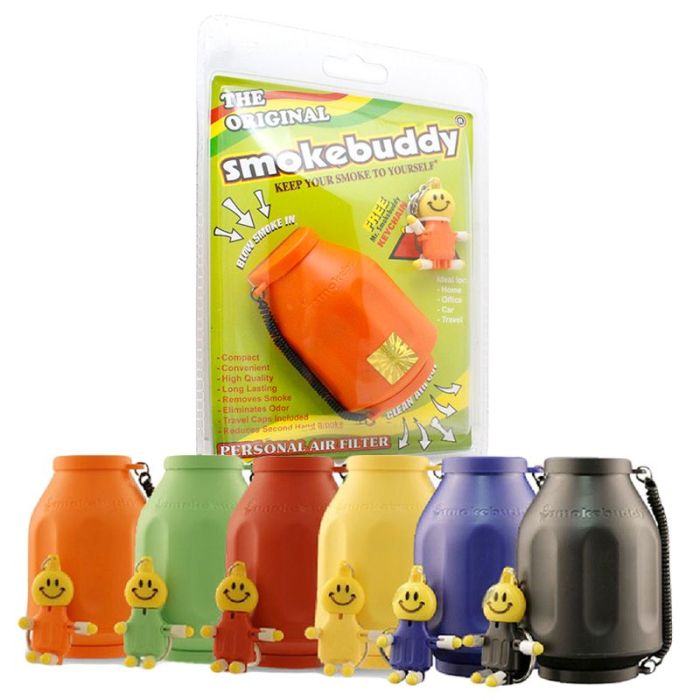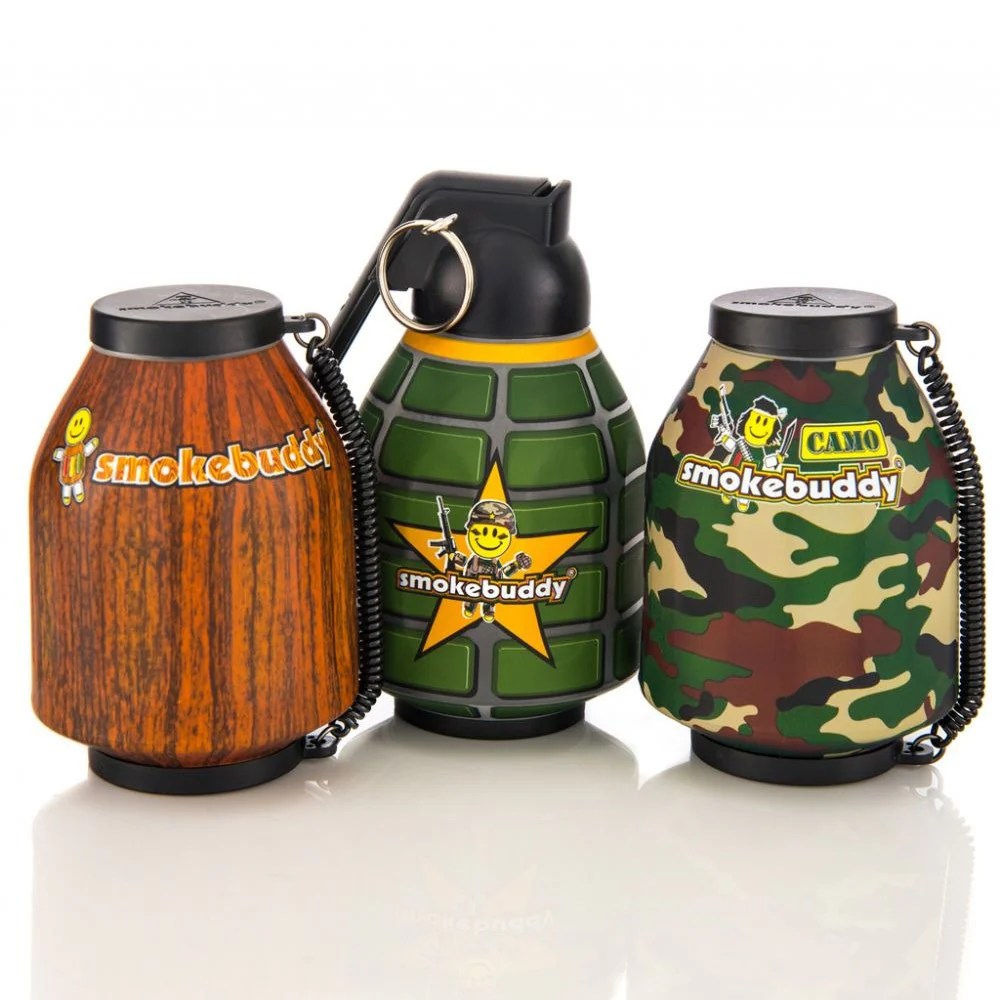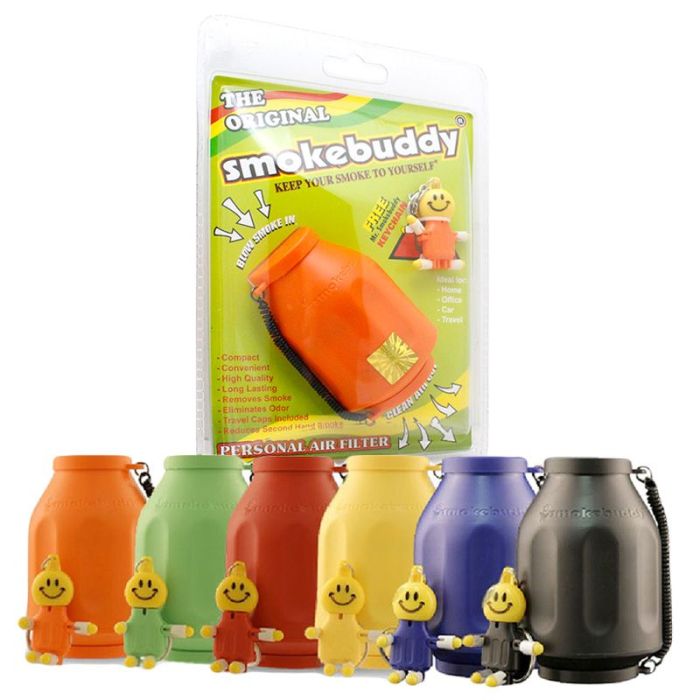DIY Smoke Buddy sets the stage for a fascinating exploration of how to create your own smoke filter, offering a blend of practicality and creativity. This guide delves into the world of DIY smoke control, exploring various designs, materials, and techniques for building your own effective and efficient smoke buddy.
From understanding the purpose and function of a smoke buddy to exploring different designs and materials, this guide provides a comprehensive overview of the DIY smoke buddy world. We’ll discuss the benefits and drawbacks of using a DIY smoke buddy compared to commercial options, as well as safety considerations and legal implications.
What is a DIY Smoke Buddy?

A DIY Smoke Buddy is a homemade device designed to filter and trap smoke before it can escape into the surrounding air. It’s a popular choice for smokers who want to reduce the smell and visibility of their smoke, especially in enclosed spaces.
The purpose of a Smoke Buddy is to provide a more discreet and odor-free smoking experience. It works by drawing smoke through a filter, usually made of activated carbon, which absorbs the majority of the smoke particles and odor molecules.
Materials Used in DIY Smoke Buddy Projects
DIY Smoke Buddy projects often use readily available and inexpensive materials. Common materials include:
- Plastic water bottle: The main body of the Smoke Buddy, providing a container for the filter.
- Activated carbon: The primary filtering material, effectively trapping smoke particles and odors.
- Cotton balls or cloth: Used as a pre-filter to catch larger particles before they reach the activated carbon.
- Scissors and tape: For cutting and assembling the water bottle and securing the filter materials.
Benefits and Drawbacks of DIY Smoke Buddies
Benefits
- Cost-effectiveness: DIY Smoke Buddies are significantly cheaper than commercial options, using readily available materials.
- Customization: You can tailor the design and filter materials to your specific needs and preferences.
- Environmental friendliness: DIY Smoke Buddies can be made from recycled materials, reducing waste.
Drawbacks
- Effectiveness: The filtering efficiency of a DIY Smoke Buddy can vary depending on the materials and construction, potentially resulting in less effective smoke reduction compared to commercial options.
- Durability: DIY Smoke Buddies might not be as durable as commercial options, requiring more frequent replacement or repairs.
- Safety: Improper construction or use of materials could pose safety risks, such as the possibility of inhaling harmful substances.
DIY Smoke Buddy Designs and Variations
DIY Smoke Buddy designs offer a range of options for those seeking a simple and affordable way to filter smoke. These designs often utilize readily available materials, allowing for customization and experimentation.
Common DIY Smoke Buddy Designs
Several common DIY Smoke Buddy designs have emerged, each with its unique features and functionalities.
- The Classic Water Bottle Design: This design involves cutting the bottom off a plastic water bottle and attaching a filter material, such as a coffee filter or a piece of cloth, to the opening. The smoke is then drawn through the water, which acts as a filter. The water bottle can be modified with additional features like a mouthpiece for easier inhalation.
- The Cardboard Box Design: This design utilizes a cardboard box with a hole cut into one side for the mouthpiece and another hole on the opposite side for the smoke intake. A filter material, such as a coffee filter or a piece of cloth, is placed inside the box to filter the smoke. The box can be further modified with additional features, such as a hose for connecting to a bong or a water pipe.
- The PVC Pipe Design: This design involves using a PVC pipe, a filter material, and a mouthpiece. The smoke is drawn through the PVC pipe, which is filled with a filter material such as activated carbon or a piece of cloth. The PVC pipe can be modified with additional features like a water chamber for better filtration.
Advantages and Disadvantages of DIY Smoke Buddy Designs
Each DIY Smoke Buddy design has its own advantages and disadvantages, depending on the materials used and the construction process.
- Advantages:
- Cost-effective: DIY Smoke Buddies are significantly cheaper than commercially available options.
- Customization: DIY designs allow for customization and experimentation with different materials and features.
- Accessibility: The materials needed for most DIY Smoke Buddies are readily available.
- Disadvantages:
- Effectiveness: The effectiveness of DIY Smoke Buddies can vary depending on the materials used and the construction process.
- Durability: Some DIY Smoke Buddies may not be as durable as commercially available options.
- Safety: It’s important to use safe and non-toxic materials when constructing a DIY Smoke Buddy.
Examples of DIY Smoke Buddy Designs Online
Numerous examples of DIY Smoke Buddy designs can be found online, showcasing different variations and techniques. These designs often include detailed instructions and materials lists, making it easier for individuals to replicate them. For example, a popular DIY Smoke Buddy design found on Reddit utilizes a plastic water bottle, a coffee filter, and a piece of cardboard. The design involves cutting a hole in the bottom of the water bottle, attaching a coffee filter to the opening, and creating a mouthpiece from cardboard.
Materials and Tools for Building a DIY Smoke Buddy
Creating a DIY Smoke Buddy requires readily available materials and tools. This section Artikels the essential components for building a functional and effective smoke filter.
Materials
The materials for building a DIY Smoke Buddy are inexpensive and can be found at most stores.
- Plastic bottle: A 1-liter plastic bottle is ideal, but any size can work. Choose a bottle with a wide mouth for easier access. The bottle will serve as the main body of the smoke filter.
- Activated carbon: Activated carbon is a key component of the smoke filter. It effectively absorbs harmful substances from the smoke. You can find activated carbon in various forms, such as granules, pellets, or powder. Look for activated carbon specifically designed for air filtration.
- Filter material: A filter material is necessary to prevent larger particles from entering the activated carbon. You can use a variety of materials, including:
- Coffee filters: Coffee filters are readily available and offer good filtration.
- Paper towels: Paper towels can be used as a temporary filter but may not be as effective as other options.
- Cloth: A thin piece of cloth can be used as a filter, but it should be washed and dried before use.
- Duct tape: Duct tape is used to secure the filter material and create a tight seal around the bottle.
- Scissors: Scissors are needed to cut the plastic bottle and filter material.
Tools
The tools for building a DIY Smoke Buddy are basic and can be found in most households.
- Scissors: Scissors are used to cut the plastic bottle and filter material.
- Marker: A marker is helpful for marking the plastic bottle before cutting.
- Measuring cup: A measuring cup is used to measure the amount of activated carbon needed.
- Funnel: A funnel makes it easier to pour the activated carbon into the bottle.
Step-by-Step s for Building a DIY Smoke Buddy
Building a DIY Smoke Buddy is a relatively simple process that requires minimal materials and tools. The following steps will guide you through the construction process.
Preparing the Materials
Before you begin assembling your DIY Smoke Buddy, it’s essential to gather all the necessary materials. This will ensure a smooth and efficient building process.
- A plastic bottle (e.g., a 1-liter soda bottle)
- A piece of cardboard or thin plastic sheet
- Scissors or a utility knife
- A marker
- A small piece of filter material (e.g., coffee filter, tissue paper)
- Optional: A small fan or blower
Cutting the Bottle
This step involves carefully cutting the plastic bottle to create the main chamber of your DIY Smoke Buddy.
- Using a marker, draw a line around the bottle about 2-3 inches from the bottom. This will be your cutting line.
- Carefully cut along the marked line using scissors or a utility knife. Ensure you make a clean cut to prevent any sharp edges.
- You can smooth out any rough edges with sandpaper or a lighter if necessary.
Creating the Filter
The filter is a crucial component of the DIY Smoke Buddy, as it traps smoke particles and prevents them from escaping into the air.
- Cut a circle of cardboard or plastic sheet that fits snugly inside the top of the bottle. This will serve as the base for your filter.
- Place the filter material (e.g., coffee filter, tissue paper) on top of the cardboard circle. You can use multiple layers for a more effective filter.
- Secure the filter material to the cardboard circle using tape or glue. Ensure the filter material is tightly secured to prevent any gaps.
Assembling the Smoke Buddy
Now that you have the main chamber and the filter prepared, you can assemble your DIY Smoke Buddy.
- Place the filter assembly on top of the cut bottle, ensuring the filter material is facing downwards.
- Optional: If you’re using a fan or blower, attach it to the bottom of the bottle to help draw air through the filter.
Using the DIY Smoke Buddy
To use your DIY Smoke Buddy, simply place your smoking device (e.g., pipe, bong) inside the bottle and inhale through the filter. The smoke will be drawn through the filter material, trapping the majority of the smoke particles.
Note: Remember to dispose of the filter material regularly to ensure optimal filtration.
Effectiveness and Efficiency of DIY Smoke Buddies
DIY Smoke Buddies, while offering a cost-effective solution to smoke and odor reduction, have varying levels of effectiveness. The efficiency of a DIY Smoke Buddy depends on several factors, including the design, materials used, and how it is used.
Effectiveness in Reducing Smoke and Odor
The effectiveness of a DIY Smoke Buddy in reducing smoke and odor depends on several factors, including the design, materials used, and the type of smoke being filtered. Generally, DIY Smoke Buddies are effective in reducing the amount of smoke and odor that escapes into the air. The effectiveness of a DIY Smoke Buddy is influenced by the following factors:
- Design: The design of the DIY Smoke Buddy plays a crucial role in its effectiveness. A well-designed DIY Smoke Buddy will have a larger surface area for smoke to pass through, allowing for better filtration.
- Materials: The materials used in the construction of the DIY Smoke Buddy also play a role in its effectiveness. Some materials, such as activated carbon, are better at absorbing smoke and odor than others.
- Type of Smoke: The type of smoke being filtered also affects the effectiveness of the DIY Smoke Buddy. For example, a DIY Smoke Buddy may be less effective at filtering smoke from burning wood than smoke from burning tobacco.
Comparison with Commercial Options
DIY Smoke Buddies are often less effective than commercial options. This is because commercial Smoke Buddies are typically designed with more advanced filtration systems and use higher quality materials. However, DIY Smoke Buddies can still be effective in reducing smoke and odor, especially if they are well-designed and constructed using high-quality materials.
Factors Influencing Efficiency
The efficiency of a DIY Smoke Buddy can be influenced by several factors, including:
- Airflow: The airflow through the DIY Smoke Buddy is crucial for its effectiveness. If the airflow is too slow, the smoke will not be filtered effectively.
- Filter Material: The type and quality of the filter material used in the DIY Smoke Buddy will affect its efficiency. Activated carbon is a highly effective filter material, but other materials, such as cotton balls or dryer sheets, can also be used.
- Maintenance: Regular maintenance of the DIY Smoke Buddy is essential for its continued efficiency. This includes replacing the filter material as needed and cleaning the DIY Smoke Buddy to remove any accumulated smoke and debris.
Safety Considerations for DIY Smoke Buddies
While DIY Smoke Buddies offer a cost-effective and convenient solution for smoke filtration, it’s crucial to prioritize safety when using them. Improper handling or construction can lead to potential hazards, and understanding these risks is essential for responsible use.
Potential Hazards
DIY Smoke Buddies, by their very nature, involve handling materials that can be hazardous if not managed correctly. It’s essential to be aware of the potential risks associated with the materials used and the design of the device itself.
- Material Toxicity: Some materials used in DIY Smoke Buddies, such as activated carbon, can be harmful if ingested or inhaled in large quantities. Always handle these materials with caution and avoid direct contact with the skin or eyes.
- Fire Hazard: The use of heat sources, like a lighter or a candle, to activate the Smoke Buddy can pose a fire risk if not handled properly. Always use these heat sources in a safe environment and ensure they are extinguished completely after use.
- Improper Design: A poorly designed Smoke Buddy may not effectively filter smoke, leading to potential exposure to harmful substances. It’s crucial to follow reliable designs and ensure the device functions correctly.
Safe Handling and Disposal
- Material Handling: Wear gloves and a mask when handling materials like activated carbon to prevent contact with the skin and inhalation of dust. Store these materials in airtight containers to prevent contamination and spills.
- Device Usage: Always use the Smoke Buddy in a well-ventilated area to prevent smoke buildup. Avoid using it in enclosed spaces, as this can increase the risk of carbon monoxide poisoning.
- Disposal: Dispose of used materials responsibly. Activated carbon can be disposed of in a sealed container, and other materials should be disposed of according to local regulations.
Importance of Proper Instructions
- Following Instructions: Carefully follow the instructions provided in the DIY Smoke Buddy guide to ensure the device is constructed and used correctly. This minimizes the risk of accidents and ensures the device’s effectiveness.
- Caution and Responsibility: Always exercise caution when using a DIY Smoke Buddy and prioritize safety. Be mindful of the potential hazards and take appropriate precautions to minimize risks.
Alternative Methods for Smoke Control: Diy Smoke Buddy

While DIY Smoke Buddies offer a cost-effective and readily available solution for smoke control, several alternative methods exist, each with its own advantages and disadvantages. Exploring these options can help you find the most suitable approach for your needs and preferences.
Air Purifiers, Diy smoke buddy
Air purifiers are designed to remove airborne particles, including smoke, dust, pollen, and other allergens. They work by filtering the air through a series of layers, typically including a pre-filter, a HEPA filter, and a carbon filter.
- HEPA filters are highly effective at trapping small particles, including smoke, while carbon filters absorb odors and gases.
- Air purifiers are particularly useful in enclosed spaces, as they can help to improve air quality and reduce the amount of smoke that is inhaled.
- However, air purifiers can be expensive, and they may not be effective at removing all smoke particles.
Ventilation Systems
Ventilation systems are designed to improve air circulation and remove stale air from a space. This can be achieved through a variety of methods, including opening windows, using fans, and installing exhaust systems.
- Ventilation systems can be effective at removing smoke, particularly if they are designed to exhaust air directly to the outside.
- However, ventilation systems can be expensive to install and maintain, and they may not be effective in all situations.
Smoke-Free Products
Smoke-free products, such as e-cigarettes and vaporizers, offer an alternative to traditional cigarettes. These products typically produce a vapor instead of smoke, which is often considered to be less harmful than smoke.
- Smoke-free products can be effective at reducing the amount of smoke that is produced, but they may not be completely smoke-free.
- It’s important to note that the long-term health effects of smoke-free products are still being studied.
Building a DIY Smoke Buddy can be a rewarding project, allowing you to customize your smoke control solution while potentially saving money. By following the steps Artikeld in this guide, you can create a functional and effective smoke buddy that meets your specific needs. Remember to prioritize safety and follow all legal and ethical guidelines. With a little effort and creativity, you can enjoy a smoke-free environment without breaking the bank.
Creating a DIY smoke buddy can be a fun and rewarding project, especially if you enjoy tinkering and want to save some money. The process is similar to building a small, efficient furnace, and you can even apply some of the same principles to projects like DIY radiant floor heating , which uses a network of pipes to distribute heat throughout a room.
Both projects require careful planning, attention to detail, and a little bit of patience, but the results can be well worth the effort.

